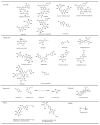UPLC-ESI-MS/MS-Based Analysis of Various Edible Rosa Fruits Concerning Secondary Metabolites and Evaluation of Their Antioxidant Activities
- PMID: 38472910
- PMCID: PMC10931279
- DOI: 10.3390/foods13050796
UPLC-ESI-MS/MS-Based Analysis of Various Edible Rosa Fruits Concerning Secondary Metabolites and Evaluation of Their Antioxidant Activities
Abstract
The genus Rosa is globally popular with well-established applications since it has a high edible and medicinal value. However, relatively limited research has been conducted on the composition and quality of wild Rosa fruits. The present study aimed to compare the properties and chemical components of five wild edible Rosa fruits, Rosa roxburghii, Rosa sterilis, Rosa laevigata, Rosa davurica, and Rosa sericea. The UPLC-ESI-MS/MS approach identified the key metabolites among the five Rosa fruits as flavonoids, phenolic acids, and organic acids. The main differential metabolites among the five fruits are flavonoids (22.29-45.13%), phenolic acids (17-22.27%), and terpenoids (7.7-24%), respectively. In total, 125 compounds served as potential markers for the five Rosa species. Differential metabolic pathways of five Rosa fruits were analyzed using the KEGG approach. Rosa laevigata fruits showed the highest total polysaccharide (TPS) content of 64.48 g/100 g. All the five Rosa extracts effectively decreased the levels of malondialdehyde while increasing the activities of superoxide dismutase and glutathione peroxidase in the H2O2-induced HaCaT cell model, demonstrating high potential for antioxidant development. Our findings suggest that the five studied Rosa fruits exhibit biological activity and edible value worth further exploration.
Keywords: Rosa laevigata; Rosa roxburghii; Rosa sericea; antioxidant activity; metabolic profiling.
Conflict of interest statement
The authors declare that they have no known competing financial interests or personal relationships that could have appeared to influence the work reported in this paper.
Figures
















Similar articles
-
Chemical Analysis of Dietary Constituents in Rosa roxburghii and Rosa sterilis Fruits.Molecules. 2016 Sep 9;21(9):1204. doi: 10.3390/molecules21091204. Molecules. 2016. PMID: 27618004 Free PMC article.
-
Metabolomics Combined with Transcriptomics Analysis Revealed the Amino Acids, Phenolic Acids, and Flavonol Derivatives Biosynthesis Network in Developing Rosa roxburghii Fruit.Foods. 2022 Jun 1;11(11):1639. doi: 10.3390/foods11111639. Foods. 2022. PMID: 35681389 Free PMC article.
-
Physicochemical, biological properties, and flavour profile of Rosa roxburghii Tratt, Pyracantha fortuneana, and Rosa laevigata Michx fruits: A comprehensive review.Food Chem. 2022 Jan 1;366:130509. doi: 10.1016/j.foodchem.2021.130509. Epub 2021 Jul 1. Food Chem. 2022. PMID: 34339923 Review.
-
Comparative metabolomic analysis reveals nutritional properties and pigmentation mechanism of tea-scented rosehips.J Sci Food Agric. 2024 Apr;104(6):3392-3404. doi: 10.1002/jsfa.13224. Epub 2024 Jan 3. J Sci Food Agric. 2024. PMID: 38105397
-
A Review on the Phytochemical and Pharmacological Properties of Rosa laevigata: A Medicinal and Edible Plant.Chem Pharm Bull (Tokyo). 2021;69(5):421-431. doi: 10.1248/cpb.c20-00743. Chem Pharm Bull (Tokyo). 2021. PMID: 33952852 Review.
Cited by
-
The Phytochemical Characterization of a Cili (Rosa roxburghii) Fruit Low-Temperature Extract with Hepatoprotective Effects.Foods. 2025 Apr 9;14(8):1301. doi: 10.3390/foods14081301. Foods. 2025. PMID: 40282703 Free PMC article.
-
Differential Analysis of Anthocyanins in Red and Yellow Hawthorn (Crataegus pinnatifida) Peel Based on Ultra-High Performance Liquid Chromatography-Electrospray Ionization Tandem Mass Spectrometry.Molecules. 2025 Mar 3;30(5):1149. doi: 10.3390/molecules30051149. Molecules. 2025. PMID: 40076372 Free PMC article.
-
Antioxidative and Cytoprotective Effects of Rosa Roxburghii and Metabolite Changes in Oxidative Stress-Induced HepG2 Cells Following Rosa Roxburghii Intervention.Foods. 2024 Nov 4;13(21):3520. doi: 10.3390/foods13213520. Foods. 2024. PMID: 39517304 Free PMC article.
References
-
- Zheng B.J., Dong L. Study on Plant Landscape of Beijing Urban Linear Parks Based on Bird Diversity Improvement. Landsc. Archit. 2019;26:53–57. doi: 10.14085/j.fjyl.2019.01.0053.05. - DOI
-
- Singh K., Sharma Y.P., Gairola S. Distribution status and ethnomedicinal importance of genus Rosa L. (Rosaceae) in India. Ethnobot. Res. Appl. 2023;25:1–22. doi: 10.32859/era.25.51.1-22. - DOI
-
- Xu J.W., Vidyarthi S.K., Bai W.B., Pan Z.L. Nutritional constituents, health benefits and processing of Rosa Roxburghii: A review. J. Funct. Foods. 2019;60:103456. doi: 10.1016/j.jff.2019.103456. - DOI
Grants and funding
- 32060081 and No. U1812403/National Natural Science Foundation of China
- 19NSP004/National Natural Science Foundation of Guizhou Medical University
- No. QKHPTRC-CXTD [2022] 007/Guizhou Science and Technology Innovation Talent Team
- No. QKHZYD [2022] 4015/The Department of Science and Technology of Guizhou Province
LinkOut - more resources
Full Text Sources

